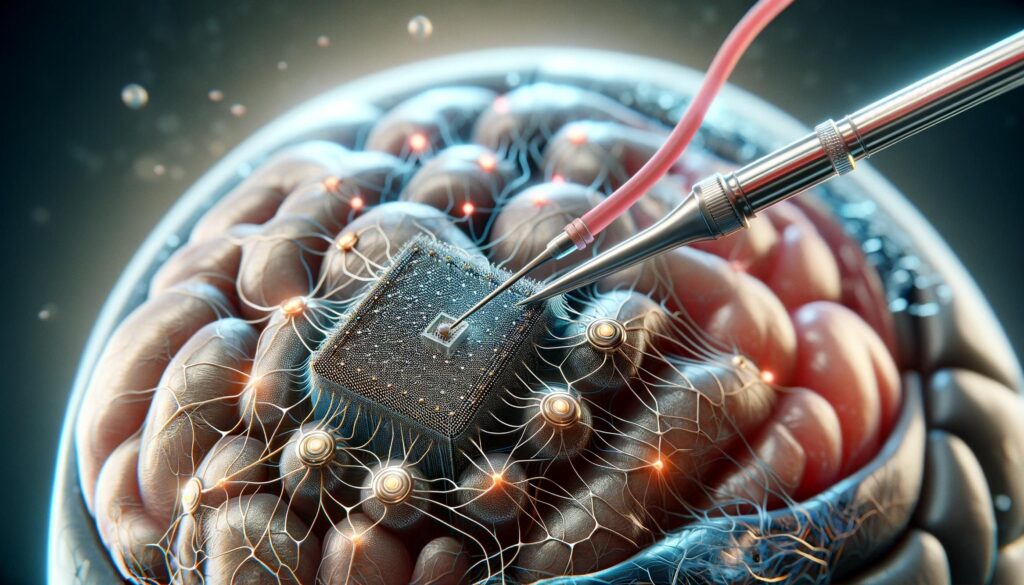A breakthrough study introduces an innovative graphene-based neurotechnology developed by ICN2 and partners, with the potential for significant advancements in neuroscience and therapeutic applications. (Artist’s concept.) Credit: SciTechDaily.com
Groundbreaking graphene neurotechnology developed by ICN2 and collaborators promises transformative advances in neuroscience and medical applications, demonstrating high-precision neural interfaces and targeted nerve modulation.
A study published in Nature Nanotechnology presents an innovative graphene-based neurotechnology with the potential for a transformative impact in neuroscience and medical applications. This research, spearheaded by the Catalan Institute of Nanoscience and Nanotechnology (ICN2) together with the Universitat Autònoma de Barcelona (UAB) and other national and international partners, is currently being developed for therapeutic applications through the spin-off INBRAIN Neuroelectronics.
Key Features of Graphene Technology
Following years of research under the European Graphene Flagship project, ICN2 spearheaded in collaboration with the University of Manchester the development of EGNITE (Engineered Graphene for Neural Interfaces), a novel class of flexible, high-resolution, high-precision graphene-based implantable neurotechnology. The results published recently in Nature Neurotechnology aim to contribute with innovative technologies to the blooming landscape of neuroelectronics and brain-computer interfaces.
EGNITE builds on the vast experience of its inventors in fabrication and medical translation of carbon nanomaterials. This innovative technology based on nanoporous graphene integrates fabrication processes standard in the semiconductor industry to assemble graphene microelectrodes of a mere 25 µm in diameter. The graphene microelectrodes exhibit low impedance and high charge injection, essential attributes for flexible and efficient neural interfaces.
Preclinical Validation of Functionality
Preclinical studies by various neuroscience and biomedical experts that partnered with ICN2, using different models for both the central and peripheral nervous system, demonstrated the capacity of EGNITE in recording high-fidelity neural signals with exceptional clarity and precision and, more importantly, afford highly targeted nerve modulation. The unique combination of high-fidelity signal recording and precise nerve stimulation offered by EGNITE technology represents a potentially critical advancement in neuroelectronic therapeutics.
This innovative approach addresses a critical gap in neurotechnology, which has seen little advancement in materials over the last two decades. The development of EGNITE electrodes has the capacity to place graphene at the forefront of neurotechnological materials.
International Collaboration and Scientific Leadership
The technology presented today builds on the legacy of the Graphene Flagship, a European initiative that during the last decade strived to advance European strategic leadership in technologies that rely on graphene and other 2D materials. Behind this scientific breakthrough is a collaborative effort led by ICN2 researchers Damià Viana (now at INBRAIN Neuroelectronics), Steven T. Walston (now at University of Southern California), and Eduard Masvidal-Codina, under the guidance of ICREA Jose A. Garrido, leader of the ICN2 Advanced Electronic Materials and Devices Group, and ICREA Kostas Kostarelos, leader of the ICN2 Nanomedicine Lab and the Faculty of Biology, Medicine & Health at the University of Manchester (UK). The research has had the participation of Xavier Navarro, Natàlia de la Oliva, Bruno Rodríguez-Meana and Jaume del Valle, from the Institute of Neurosciences and the Department of Cellular Biology, Physiology and Immunology of the Universitat Autònoma de Barcelona (UAB).
The collaboration includes the contribution from leading national and international institutions, such as the Institut de Microelectrònica de Barcelona – IMB-CNM (CSIC), the National Graphene Institute in Manchester (UK), and the Grenoble Institut des Neurosciences – Université Grenoble Alpes (France) and the University of Barcelona. The technology integration into the standard semiconductor fabrication processes has been performed at the Micro and Nanofabrication cleanroom of the IMB-CNM (CSIC), under the supervision of CIBER researcher Dr. Xavi Illa.
Clinical Translation: Next Steps
The EGNITE technology described in the Nature Nanotechnology article has been patented and licensed to INBRAIN Neuroelectronics, a spin-off based in Barcelona from ICN2 and ICREA, with support from IMB-CNM (CSIC). The company, also a partner in the Graphene Flagship project, is leading the translation of the technology into clinical applications and products. Under the direction of CEO Carolina Aguilar, INBRAIN Neuroelectronics is gearing up for the first-in-human clinical trials of this innovative graphene technology.
The industrial and innovation landscape on semiconductor engineering in Catalonia, where ambitious national strategies plan to build state-of-the-art facilities to produce semiconductor technologies based on emerging materials, offer an unprecedented opportunity to accelerate the translation of such results presented today into clinical applications.
Closing Remarks
The Nature Nanotechnology article describes an innovative graphene-based neurotechnology that can be upscaled using established semiconductor fabrication processes, holding the potential for a transformative impact. ICN2 and its partners continue to advance and mature the described technology with the aim to translate it into a real efficacious and innovative therapeutic neurotechnology.
Reference: “Nanoporous graphene-based thin-film microelectrodes for in vivo high-resolution neural recording and stimulation” by Damià Viana, Steven T. Walston, Eduard Masvidal-Codina, Xavi Illa, Bruno Rodríguez-Meana, Jaume del Valle, Andrew Hayward, Abbie Dodd, Thomas Loret, Elisabet Prats-Alfonso, Natàlia de la Oliva, Marie Palma, Elena del Corro, María del Pilar Bernicola, Elisa Rodríguez-Lucas, Thomas Gener, Jose Manuel de la Cruz, Miguel Torres-Miranda, Fikret Taygun Duvan, Nicola Ria, Justin Sperling, Sara Martí-Sánchez, Maria Chiara Spadaro, Clément Hébert, Sinead Savage, Jordi Arbiol, Anton Guimerà-Brunet, M. Victoria Puig, Blaise Yvert, Xavier Navarro, Kostas Kostarelos and Jose A. Garrido, 11 January 2024, Nature Nanotechnology.
DOI: 10.1038/s41565-023-01570-5


